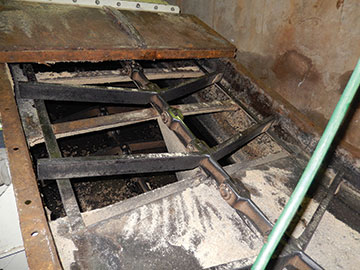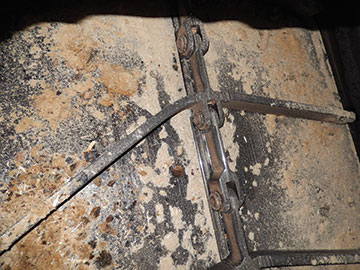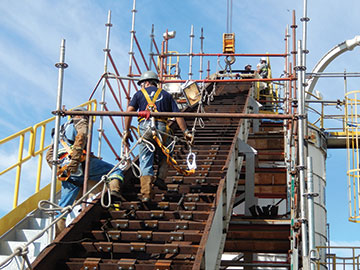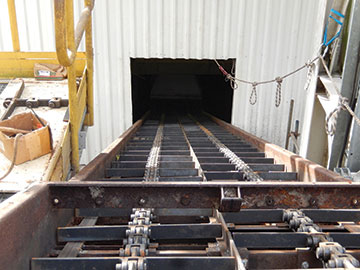Wood Products Manufacturer
En-Masse Twin Chain Retrofit Gets a Brazilian Wood Products Manufacturer Running at Full Capacity
Download PDF
CHALLENGE
Poor design and sizing of the existing conveyors complicated by incorrect flight selection meant the conveyors could not handle the required loads or the characteristics of the material. The material handling challenges lead to conveyor failure and unplanned downtime.
PRODUCTS UTILIZED
Drop-Forged Chain
En-Masse Conveyor
The Detrimental Impact of Misapplied Conveying Technology on Manufacturing Output
 A Brazilian manufacturer of OSB and MDF wood-based products used En-Masse conveyors to move raw materials from off-load, through distribution, and through the manufacturing process. The plant layout and output capacity were designed to generate a final product volume that would provide optimum returns to the company. The positive output was based on a high volume, consistent flow rate of raw materials throughout the facility.
A Brazilian manufacturer of OSB and MDF wood-based products used En-Masse conveyors to move raw materials from off-load, through distribution, and through the manufacturing process. The plant layout and output capacity were designed to generate a final product volume that would provide optimum returns to the company. The positive output was based on a high volume, consistent flow rate of raw materials throughout the facility.
The use of En-Masse drag chain technology was the ideal selection for this material handling application; however poor design and sizing of the conveyors complicated by incorrect flight selection meant the conveyors could not handle the required loads or the characteristics of the material.
The material handling challenges lead to conveyor failure and unplanned downtime. After two years of running the conveyors on a continued repair and replace maintenance schedule, the plant decided to seek alternatives.
CDM Systems was called to the manufacturing site to analyze the current situation and offer a recommended solution.
Upon review of the application and applied conveying equipment, the following summary and root cause was submitted to the facility managers.
- Conveyors did not meet design capacity criteria.
- Improper use and application of chain within the conveyor.
- Undersized and improperly applied gear reducer selection.
- Poorly designed conveyor housing and return system for the conveyor.
CDM was asked to redesign conveyors that would meet the production goals of the plant while keeping retrofit costs low. The facility management stipulated CDM to work with the existing equipment to implement improvements and eliminate the conveying problems.
 The first issue addressed by the CDM design team was the inability of the existing conveyors to meet the required capacity. The conveyors are required to handle the full volume of chips/flake the plant produced. The deficiencies of the conveyors left the plant limited to approximately 80% of the design capacity. The primary conveyor should have been sized to handle product from six flakers.
The first issue addressed by the CDM design team was the inability of the existing conveyors to meet the required capacity. The conveyors are required to handle the full volume of chips/flake the plant produced. The deficiencies of the conveyors left the plant limited to approximately 80% of the design capacity. The primary conveyor should have been sized to handle product from six flakers.
Each time the wood product manufacturer attempted to operate all six of the flaker units, the conveyor immediately plugged and shut the plant down. A design analysis of the conveyor cross sectional area (volume) determined the conveyors were significantly undersized.
The solution for this conveying problem would typically be to increase the chain speed or to provide a complete replacement of the conveyor.
However, CDM was able to address this design flaw by increasing the sidewall height of the conveyor through the use of formed channels which were bolted to the existing conveyor sidewall. These extensions, combined with raising the chain return rail elevation, provided the increase in area required to meet the design capacity without increasing chain speed.
The second material handling challenge CDM looked to overcome was the continual conveyor stoppage due to component failure. The existing conveyors in the facility were constantly failing due to chain damage, bent chain flights, broken chain, and excessive wear. The component failure was compounded by the lack of safeguards designed to mitigate the damage following the failure.
CDM addressed these issues with minimal cost to the facility’s retrofit budget by adding a zero speed switch to each conveyor. The switch, coupled with the addition of a CDM exclusive Kick-Out End Flap, serves as a plug chute and chain break indicator. The use of the two added sensors would significantly reduce the damage and associated downtime from an upset condition.
Another conveyor design issue identified by the CDM engineering team was the misapplication of the chain. The chain pull and ultimate strength did appear to be calculated and applied accurately; however, the conveyors were designed with a single strand chain with a 50” (1250mm) wide flight.
This flight design was too wide of a span for a single strand conveyor. The tip strength of the flights could not withstand the forces of the product at the design capacity without deflection.
This design flaw left the conveyors vulnerable to continued failure during normal operating conditions and potential catastrophic failure in an upset condition. A seemingly obvious fix would be to simply increase the flight thickness to increase the flight tip strength.
However, increasing the thickness of the flights would lead to greater lateral forces on the chain and result in more chain breaks and failures in place of the bent flights. While bent flights are inconvenient, they do not typically lead to a shut-down like a broken chain.
Engineered Chain Proves Reliable
CDM had two options to correct this design flaw. The first choice was to offer a conventional dual strand chain where two strands of chain would be installed with a common flight connecting the (2) strands. While this is not an uncommon arrangement, it was not the design option CDM recommended for the following reasons;
- Regardless of chain manufacturer, type of chain, alloy of chain or style of chain. No two strands of chain will ever wear or elongate at exactly the same rates. With a conventional dual strand arrangement this is a critical consideration as once this uneven elongation occurs you have effectively changed the chain sprocket centers. As the chain engages the drive shaft sprockets it is not contacting the sprockets correctly or if uneven elongation is sever enough will not engage at all. This will lead to a failure. Chain elongation becomes an even greater issue when the conveyor has a long run; which means more links in the conveyor.
- When a conventional dual strand conveyor is used, if a flight becomes bent due to upset condition or foreign material the sprocket centers have again been changed. This will result in conveyor failure when the chain engages the sprockets.
 Many of the conveyor lengths were in excess of 150 ft. (46 m). At this long span, CDM knew the dual strand design would not be the best selection for this application.
Many of the conveyor lengths were in excess of 150 ft. (46 m). At this long span, CDM knew the dual strand design would not be the best selection for this application.
Instead, CDM proposed its exclusive Twin-Strand design.
The CDM design combines the capacity advantage of a dual strand with the reliability of a single. Instead of a conventional dual strand where the two strands of chain are connected with the chain flight; the CDM Twin-Strand design uses two independent single strands of chain within the same conveyor housing. Like a dual strand, the twin design uses a common drive shaft, where both strands of chain are driven through a single drive package.
Unlike a conventional dual strand, the Twin-Strand design is provided with independent take-ups/chain tensioning. The result is a conveyor that combines the capacity advantages of a dual strand conveyor with the long-term operational reliability of a single strand conveyor into a single piece of equipment. The use of the CDM Twin-Strand design provided several key benefits for the application:
- Increased chain strength
- Increased chain flight strength
- Eliminated issues from uneven elongation
- Virtually eliminated bent flights
Upon design completion, CDM provided the wood product manufacturer detailed fabrication drawings of the modifications required to the existing conveyor to accommodate the conversion. The drawings allowed the company to hire a local contractor to perform the fabrication and installation.
The use of local subcontractors saved thousands of dollars in shipping costs and taxes/tariffs on US supplied components. CDM also supplied fabrication details and design criteria for the terminal station retro-fit which were required to accommodate the Twin-Strand design.
The original gear reducer selection for the conveyors was provided with virtually no service factor based upon the output torque required for the conveyor. To support the full capacity of manufacturing output and the new TwinStrand design, CDM engineered and specified a new drive package (reducer/motor).
The new package could be purchased locally and would support the full material handling requirements of the plant.
A Successful Retrofit Based on Experience and Partnership
 The communication and partnership between CDM Systems and the Brazilian wood product manufacturer solidified the success of the retrofit material handling project.
The communication and partnership between CDM Systems and the Brazilian wood product manufacturer solidified the success of the retrofit material handling project.
The CDM design team relied on the more than 40 years of experience in bulk material handling and En-Masse conveyor design, to analyze the failed conveying system in the plant, to listen and understand the goals of the manufacturer to keep retrofit costs low and production at peak levels, and to collaborate with their Brazilian customer to provide detailed work instructions and component specifications to keep the project on schedule and eliminate unnecessary tariffs.
Since the completed retrofit, the manufacturer has reached full production targets and has improved its bottom line. The success of the project has also led to (2) sister-companies of the wood product manufacturer to contact CDM for assistance with their struggling conveying system.
Browse By Benefit
Categories
- Blog (40)
- Case Studies (9)
- News (7)
- Product Information (7)
- Tech Briefs (3)
- Technical Documents (33)
- Uncategorized (1)
- Videos (12)
- White Papers (5)

